|
Brian
Croser, Petaluma and Tapanappa, part three
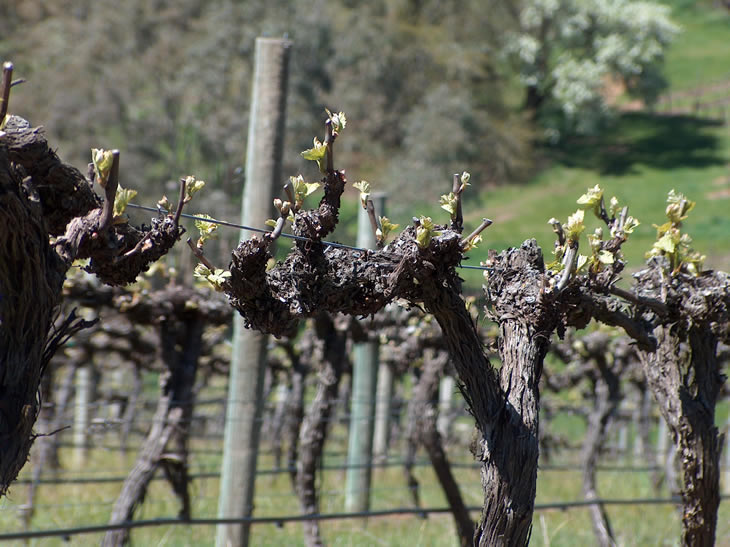
Budburst, Adelaide
Hills
Part
three of the report of my brief sojourn in the Adelaide Hills with
Brian Croser will be a bit of a piecemeal collection of odds and
ends, but I think they are interesting, important odds and ends,
so please bear with me.
After
the Petaluma vertical tasting I reported on earlier, we tasted a
few more wines from Petaluma, took a look at cask samples of the
2004 Tapanappa, and then set off on a brief tour of the Piccadilly
Valley. This was followed by lunch at one of Adelaideís top
restuarants, Bridgewater Millówhich also happens to be in the
Adelaide Hills and is the cellar door for Petaluma. Iíll deal
with these segments in order.
Petaluma
Viognier 2003 Adelaide Hills
The site chosen for Viognier is at 350 m above sea level with
large differences between night and day temperatures. This is a
pretty, aromatic white wine with peach and apricot fruit.
Thereís a nice softness of texture on the palate. Good
definition; a pleasant, open style. Very good/excellent 90/100
Petaluma
Chardonnay 2003 Piccadilly Valley
Rich, open aromatic nose of sweet, tropical fruit. Quite
aromatic with some classy oak. The palate is rich and open showing
nice concentration of soft fruit. Buttery, toasty richness, too.
Very good/excellent 92/100
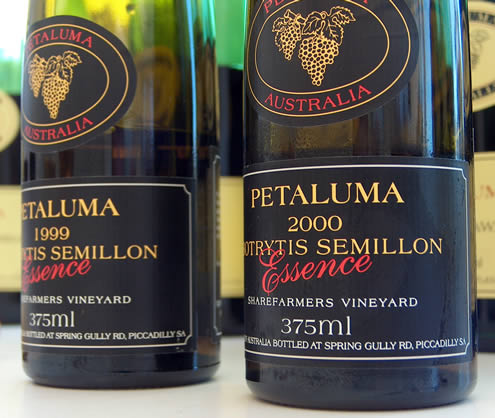 Petaluma
Botrytis Semillon Essence 1999 Petaluma
Botrytis Semillon Essence 1999
The name of this wine rather unfortunately abbreviates to BSE.
But the wine is great. Dark, rich, sweet apricotty nose is
luscious and sweet. On the palate thereís fantastic
concentration. Viscous, intense and luscious. Supersweet and
almost semi-solid. Beguiling. Excellent 95/100
Petaluma
Botrytis Semillon Essence 2000
Not so sweet on the nose: this has much more acid on the
sweet, lush apricotty nose. Full and rich with more lemon to the
fruit profile. Very good/excellent 93/100
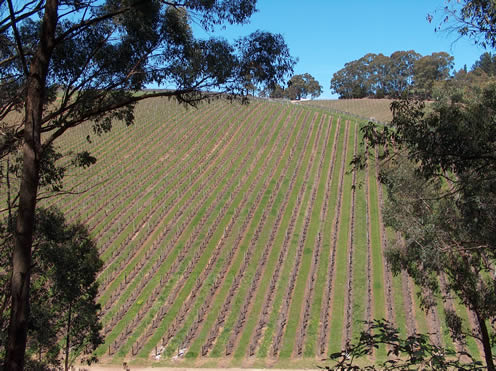
Selection
of Tapanappa cask samples
As mentioned earlier,
Tapanappa is the new super premium label launched by Croser in
collaboration with Bollinger and Jean Michel Cazes. The first wine
is the Whalebone Vineyard red, which comes from a vineyard at the
end of Coonawarra thatís part of the Wrattonbully appellation,
and which Croser has had his eye on for a long time. First
vintage, 2003, is a pretty smart wine. Further wines will come,
including Chardonnay from his Tiers vineyard, a Pinot Noir from
the Fleurieu Peninsula, and no doubt more wines from distinguished
sites in Australia and perhaps also in Europe.
It
was interesting to try these Whalebone components. Brian explained
that the Cabernet contributes aromas, the Merlot structure and the
Shiraz the flavours. Tasting these samples this becomes clear: on
their own, none of these would be complete wines, but you can see
what they might bring to a blend. With components of this quality,
itís likely the 2004 Tapanappa will be a serious effort.
Tapanappa
2004 Cabernet Sauvignon
Lovely sweet supple nose with a spicy, gingery edge.
Supersmooth supple structure. Rich, ripe, but elegant. Chocolatey
finish. Very refined.
Tapanappa
2004 Merlot
Quite vivid with a subtle green edge. Nice weight and
structure, too. This has more definition. Spicy and tannic.
Tapanappa
2004 Shiraz
This has a different mouthfeel: itís showing sweet
liquoricey fruit with a fuller mid-palate. Ripe and full, this is
quite weighty but not too well defined.
Tapanappa 2004 Cabernet Franc
Nicely expressive Cabernet Franc character: this has a subtle
leafy aromatic element and nice spicy structure. Interesting.
Adelaide
Hills tour
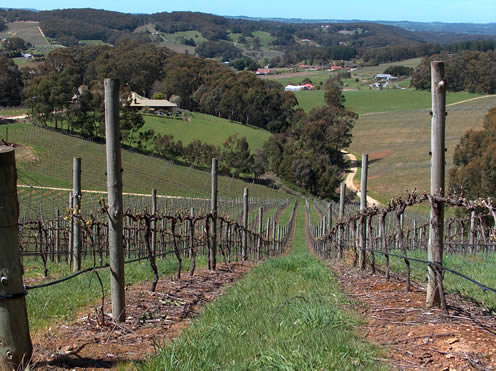 While
the Adelaide Hills region has been a wine growing area since the
late 19th century, it more-or-less stopped producing and was only
rediscovered as a good place too grow grapes as recently as 1978.
At this time there were zero hectares of vines, and in 1990 the
only vineyards were at Lenswood (Geoff Weaver was one of the
pioneers) and Brian Croserís in the Piccadilly Valley. By 1999
there were 1982 ha, and by 2004 this had grown substantially to
3338 ha. While
the Adelaide Hills region has been a wine growing area since the
late 19th century, it more-or-less stopped producing and was only
rediscovered as a good place too grow grapes as recently as 1978.
At this time there were zero hectares of vines, and in 1990 the
only vineyards were at Lenswood (Geoff Weaver was one of the
pioneers) and Brian Croserís in the Piccadilly Valley. By 1999
there were 1982 ha, and by 2004 this had grown substantially to
3338 ha.
Brian
explained that this is actually quite a diverse region. Itís
thought of as cool climate, but some bits can get reasonably warm.
Here are some figures, for what they are worth:
-
Piccadilly
has 1177 degree days (a measure of heat summation during the
growing season) and 1.4 m annual rainfall (the only red that
will ripen here is Pinot Noir);
-
Lenswood
has 1300 degree days and 1 m annual rainfall;
-
Mount
Barker had 1413 degree days and 766 mm annual rainfall.
By
way of comparison, Coonawarra is 1444, Clare is 1737 (but has cold
nights). Blenheim in New Zealand has 1101 degree days.
see
the photogallery of images from
the Adelaide Hills for more

Brian Croser
Lunch
at Bridgewater Mill
After the vineyard tour,
we headed to Bridgewater Mill, which as well as being the cellar
door for Petalumaís wines, is also one of Adelaideís top
restaurants. Joining us for lunch was a roll call of the great and
good of the Adelaide Hills wine scene, including Geoff Weaver and
Michael Hill Smith. The food was first rate, and to wash it down
was a selection of older wines.
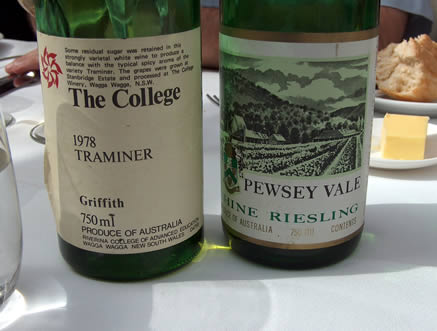 Pewsey
Vale Rhine Riesling 1975 Eden Valley, Australia Pewsey
Vale Rhine Riesling 1975 Eden Valley, Australia
Remarkably, this wine is sealed with both a screwcap and a
cork. Lovely fresh, full limey nose leads to a full palate with a
savoury texture and some petrolly, limey notes. Crisp and full
with a fresh finish.
The
College Traminer 1978 Griffith, New South Wales, Australia
Screwcapped. One of Croserís wines from his time at Wagga
Wagga. Lovely aromatic sweet, slightly herbal nose. The palate is
quite bright with nice fruit and a sweet tangy finish. Beautifully
rounded and aromaticóa nice wine.
Mount
Pleasant Semillon 1986 Hunter Valley, Australia
Golden colour. Rich, rounded, toasty and full, with a sweet
edge. The palate is rounded, rich and toasty with nice tangy
acidity. Rich with bakery flavours. Interesting. Very
good/excellent 90/100
Geoff
Weaver Fergus Sauvignon Blanc 2004 Lenswood, Adelaide Hills,
Australia
This is a wild yeast ferment Sauvignon left on lees for a year
in old barrels. 48 cases only. Lovely aromatic complexity: spicy
with some fruit richness. The palate shows nice concentration and
good acidity. Expressive and beguiling with pure and natural
flavours. Very good/excellent 91/100
(Blind
wine) Ch‚teau
Reynella 1953 Australia
Deep colour with distinctive browning. Very evolved with
slightly sweet, smooth nose with madeira character. The palate is
smooth and savoury with earthy, undergrowthy spiciness on the
finish. Substantial concentration and notes of raisins and prunes.
Interesting but a bit past it. Croser describes this as a ĎPorty
Australian Shiraz with age. Many Shiraz wines being made now will
end up like thisí.
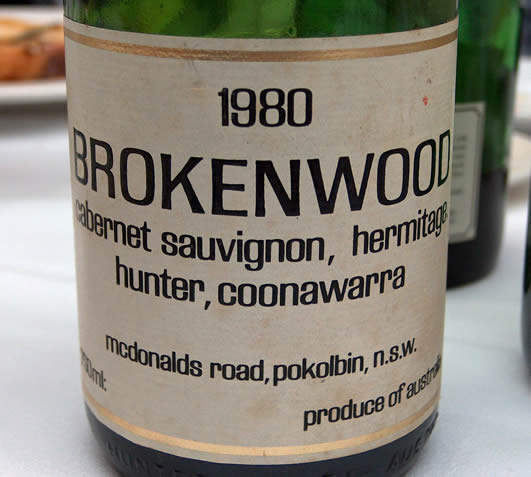 Brokenwood
Cabernet Sauvignon/Hermitage 1980 Coonawarra/Hunter Valley,
Australia Brokenwood
Cabernet Sauvignon/Hermitage 1980 Coonawarra/Hunter Valley,
Australia
A multi region blend incorporating Coonawarra Cabernet with
Hunter Shiraz. Lovely savoury, pefumed earthy, spicy nose, with
the earthiness dominating. The palate is savoury and earthy with
nice spiciness. Drinking really well: still alive with great
balance. Very good/excellent 90/100
Geoff
Weaver Coonawarra Cabernet Sauvignon Merlot 1985 Coonawarra,
Australia
Grapes here are from Katnook (the vineyard is called Margaux),
and the wine was made at Petaluma. Beautiful stuff, drinking
really well, with sweet, seamless fruit. Very refined. Very
good/excellent 93/100
Armand
Rousseau Chambertin Clos de BŤze 1999 Burgundy
Beautifully perfumed with a still-tight nose showing ripe red
fruits and fine spiciness. The palate shows huge concentration
with firm but ripe spicy structure and a nice rich finish. Itís
a bold, serious wine Ė young but with huge potential. Excellent
96/100
see
also: Part 1, Part
2, photos from the Adelaide
Hills
Wines
tasted 10/05
Find
these wines with wine-searcher.com
Back
to top
|

